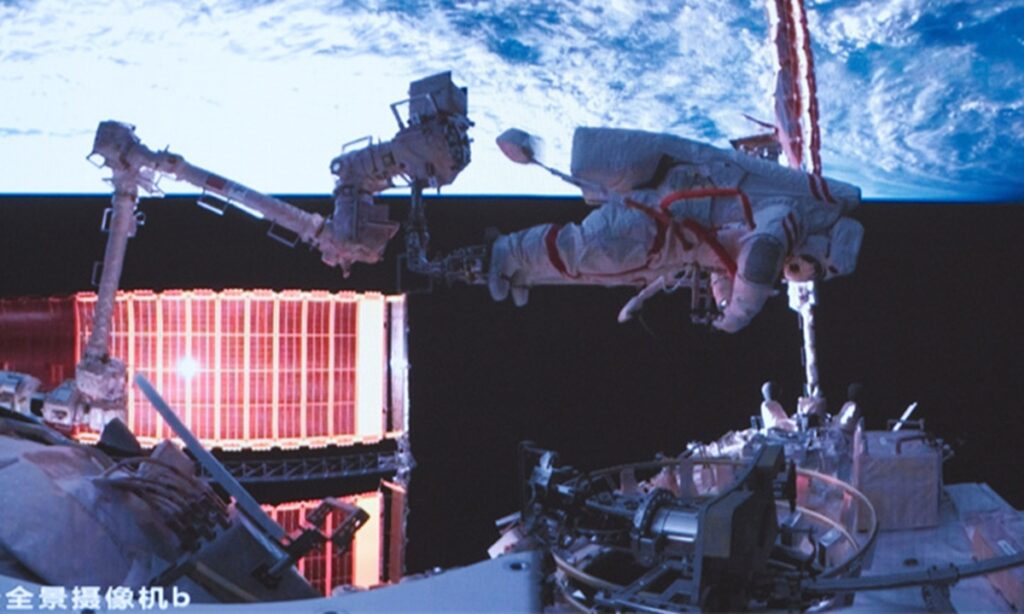China’s space exploration has made history once again. On Tuesday, the Shenzhou-19 crew members – astronauts Cai Xuzhe, Song Lingdong and Wang Haoze – closely coordinated with each other and, with the assistance of the space station’s robotic arm and a team on Earth, successfully completed the first extravehicular activities (EVAs) of their mission in nine hours. This achievement set a new record for the duration of EVAs by Chinese astronauts. CNN noted that this duration surpassed the previous record of eight hours and 56 minutes set by US astronauts in 2001, calling it the “latest milestone” in China’s space technology development. This accomplishment marks another significant step in both China’s space exploration and humanity’s overall progress in space, which is worth celebrating.
Looking back at the history of human spacewalk, it is evident that this is a gradual accomplishment. 59 years ago, a Soviet cosmonaut became the first person to walk in space, lasting about 12 minutes. 23 years ago, US astronauts set the record for the longest EVAs. 16 years ago, astronaut Zhai Zhigang during the Shenzhou-7 mission conducted China’s first spacewalk, lasting approximately 19 minutes.
Now, China has once again raised the limits of human adaptability to the space environment. From 19 minutes to nine hours, this is a major advancement for China’s space program, reflecting improvements in material science, engineering design and other fields, represented by the two generations of spacesuits, as well as the enhancement of astronaut skills and psychological endurance through scientific training. The nine-hour EVAs also indicate the rich scientific research activities conducted aboard the Chinese space station. Therefore, it is completely natural for people to feel proud and excited when this good news reaches Earth.
In space exploration, although China is a latecomer, it has become a leader and contributor. Media outlets in countries such as India, Pakistan, and Thailand have widely covered the record of China’s spacewalk, reflecting the attention and expectations of many “Global South” countries regarding China’s advancements in space technology. Amid the surging wave of modernization among “Global South” nations, space cooperation between China and these countries is thriving.
For instance, the six earth-resource satellites jointly developed by China and Brazil have been safeguarding the Amazon rainforest for over 30 years. China’s Fengyun meteorological satellites have helped numerous African countries enhance early warning capabilities. A Thailand-developed global space weather monitoring device will, for the first time, enter deep space from Earth orbit aboard the Chang’e-7 mission. Furthermore, China is “teaching others to fish,” helping “Global South” countries cultivate local aerospace talent and promoting technology transfers. These collaborations not only break the past exclusivity of space exploration by an “elite club” of nations and fulfill the space dreams of many developing countries, but they also bring tangible benefits to local livelihoods.
China’s space cooperation with other nations is systematic. Beyond empowering livelihoods through technology, it also aims to jointly explore cutting-edge cosmic science.
An article in The New York Times in 2022 posed the question, “Why some scientists choose China’s Space Station for research?” It said that scientists living in countries that are outside of the partnership are generally shut out of the International Space Station, but China “has offered opportunities for scientists from any country to get their experiments carried to the Tiangong space station.”
Currently, nine projects from 17 countries and 23 entities have been included in the first batch of selected projects for the China Space Station science experiment. In the future, international astronauts will also join Chinese counterparts for joint missions. Tiangong, this “space home,” is emerging as an international public good, demonstrating the immense value of China’s commitment to opening-up and collaboration.
Space exploration represents humanity’s boldest imagination and cutting-edge manufacturing capabilities, requiring substantial technological support and resource investment. Over decades of development in the aerospace industry, each technological powerhouse has carved out its own areas of expertise. In this context, the broader the “circle of friends” for space cooperation, the stronger the international community’s ability to jointly address global challenges such as climate change and space debris, as well as to explore the deeper mysteries of the universe. In this regard, China stands out as a “top student.” China has signed nearly 200 international cooperation agreements with over 50 governments and international organizations, promoting the exchange and cooperation of space technology in the field of peaceful use.
Following the successful return of the Chang’e-6 lunar module, Chang’e 7 and 8 have also received more international payload applications. Outer space is a shared domain for humanity, and space exploration is a common endeavor. Therefore, the fewer the restrictions imposed and the more cooperation achieved, the greater the potential that humanity can unleash.
In 2003, when the Chinese people entered space for the first time, astronaut Yang Liwei of Shenzhou 5 wrote: “The Chinese have arrived in space, for the peace and progress of humanity.” 21 years have passed, and China’s original intention of peacefully utilizing outer space for the benefit of all humanity has not changed; in fact, every step taken has become more solid. The new record for spacewalk duration is nine hours, and in the future, this record will surely be extended with advancements in technology. What we want the international community to see is that China will make greater contributions to building a community with a shared future for humanity in outer space. Human activities in outer space can completely transcend competition and achieve win-win outcomes.
GT




